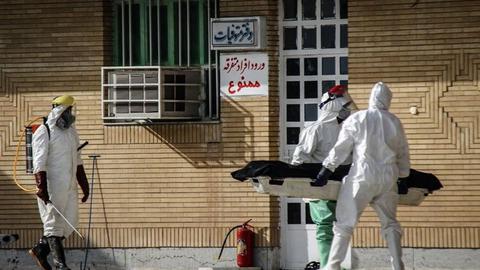BBC Persian reports that the real number of deaths from Covid-19 is 42,000, confirming global speculation that the Iranian government has been concealing true figures regarding the pandemic.
BBC Persian said it had received leaked medical evidence about the true death toll in Iran, as well as lists of names of those who had died. As of July 20, 42,000 people had died — more than three times higher than the official figure, which the government most recently reported as 16,147.
In a daily briefing on July 20, the health ministry reported a total of 14,405 deaths.
Information obtained by BBC Persian said that more than 450,000 people in Iran had contracted the virus, which is more than one and a half times the official statistics.
Prior to the BBC report, statistics from the Iranian National Civil Registry Office regarding deaths for winter and spring 2020 showed that the actual number of Covid-19 deaths was higher than the figures provided by the Ministry of Health.
The leaked data reveals the low death toll reported in official statistics was not due to a lack of information — for example, a shortage of tests or laboratory capacity — but due to a policy of disinformation. Iranian officials have deliberately presented fewer deaths in their statistics, despite centralized data being collected on coronavirus-linked deaths.
Officials at Iran's Ministry of Health did not respond to BBC Persian’s request for comments.
What Information Was Given to BBC Persian?
An anonymous source provided the information to BBC Persian. The source, who identified himself as a staff member of an official Iranian government department, sent separate lists of Covid-19 deaths and patients being treated at medical centers and hospitals in Iran to BBC Persian. The source said he or she could not reveal their identity in order to protect their own safety and that they were handing the information over to the BBC because they wanted to "reflect the truth" and end the "politicization" of the data about the pandemic.
The BBC was unable to confirm that the anonymous source was actually employed by the government or any of its official institutions, and it was unclear how he or she obtained the information about coronavirus deaths and cases. However, the BBC carried out its own verification process of the data, comparing it with other available figures and statistics, including previously confirmed figures available to the BBC. It considers the data to be accurate and verified.
The BBC confirmed the lists include information regarding people who died from Covid-19, those who died with Covid-19 symptoms, and those who had symptoms and were hospitalized or attended medical facilities. The figures are updated up to July 20, 2020.
A comparison of the death toll on these lists with official statistics reveals the same under-estimation of death toll figures as previously reported by the BBC and citing statistics from the Civil Registry Office.
The lists supply dates, times, and the hospitals where patients were treated, as well as the names of the physicians who treated them. It also lists the patients’ symptoms and any underlying pre-conditions.
Information regarding patients' identities, including last names and national identity numbers, have been redacted.
The lists include people who attended medical centers or hospitals. It does not include those who died in private homes or nursing homes.
What Does the Leaked Information Say About the Coronavirus Outbreak in Iran?
According to the information given to the BBC, as of July 20, a total of 41,952 people had died in Iranian medical centers who had been either diagnosed with Covid-19 or were suspected of having contracted the disease.
This is 2.8 times higher than the official figure of 14,405 released by the Ministry of Health on July 20.
Prior to the leaked documents being presented to the BBC Persian Service, the news service relied on the general statistics supplied by Iran’s Civil Registry Office of all deaths in Iran. Taking into account the reduction in accidents usually recorded over the Iranian new year holiday in March, it had reached a similar figure regarding the number of Covid-19 deaths by the end of spring.
Examination of the new data supplied about patients and their deaths shows the prevalence of this disease intensified on a steep curve in March and the increase of patients continued in April, then decreased in May and June, but intensified again in July.
According to this information, 52 coronavirus deaths were registered in February 2020.
The number of deaths in March increased significantly, to a total of 7,865 people. This number is higher than the estimates based on Civil Registry Office statistics and its calculation of additional deaths.
In April, 10,621 people died from Covid-19. In May and June, deaths were 6,343 and 6,469, respectively.
This reduction in mortality rates appears to be linked to government-imposed lockdown measures to control the outbreak, which were put in place in March and April.
In July, following the lifting of restrictions, the death toll rose again to 10,604 by July 20. According to these figures, July was the deadliest month of Iran’s coronavirus outbreak.
The list delivered to the BBC does not include the deaths on July 20 or after. The information available up to July 20 indicates the deadliest days of the outbreak in Iran were March 14 and March 16, when there were 487 and 469 registered deaths, respectively.
After these two, 11 July was the deadliest day of the coronavirus outbreak, with 458 deaths.
Since February 26, 2020, Iran has not experienced a single day when the death toll has been less than 100.
The leaked information reveals the huge gap between the relatively low official figure of coronavirus cases and the actual number of people who had contracted the virus. Over time, the gap has narrowed, although the death toll is still more than double the official daily figure.
What is the Situation Province by Province?
According to the data supplied to BBC Persian, since the beginning of the coronavirus outbreak in Iran up to July 20, 2020, 8,120 people died from suspected Covid-19 in Tehran province, the highest death toll among all provinces in Iran.
After Tehran province, the provinces of Razavi Khorasan and Khuzestan have the highest number of deaths, with 3,950 and 3,219 respectively.
Assessing the number of deaths according to the population of each province indicates that Qom province, with 1,419 deaths, has suffered the most severe loss of life in proportion to its population. One out of every thousand residents in Qom lost a life to coronavirus. After Qom, the provinces of Gilan and Golestan, with 2,249 and 1,639 deaths respectively, have been hardest hit in terms of deaths per population.
What Else Do the Leaked Documents Say?
In addition, the data sets out that a total of 451,024 people were hospitalized or referred to medical centers with Covid-19 or with Covid-19 symptoms by July 20.
Of these, 29,199, or six percent of all hospitalized patients, underwent intubation or tracheal intubation procedures to help them breathe.
Only 100,000 of this number — less than a quarter of the total figure — were reported to have had a history of contact with people who had confirmed cases of Covid-19, indicating that Iran had a high prevalence of asymptomatic carriers of the disease.
Read IranWire's coronavirus chronology
visit the accountability section
In this section of Iran Wire, you can contact the officials and launch your campaign for various problems


























comments